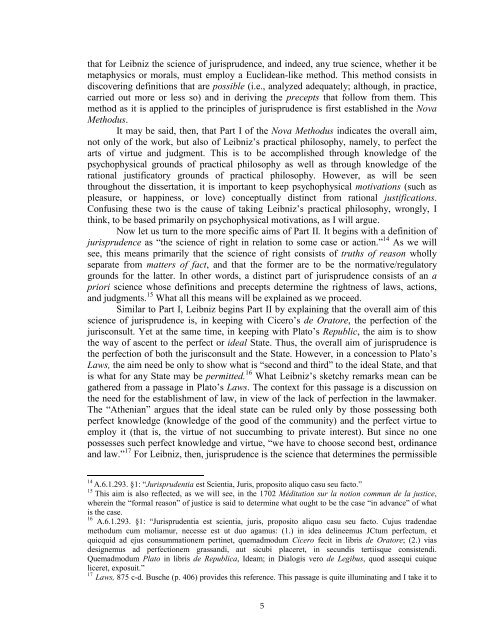Stony Brook University
Stony Brook University
Stony Brook University
You also want an ePaper? Increase the reach of your titles
YUMPU automatically turns print PDFs into web optimized ePapers that Google loves.
that for Leibniz the science of jurisprudence, and indeed, any true science, whether it be<br />
metaphysics or morals, must employ a Euclidean-like method. This method consists in<br />
discovering definitions that are possible (i.e., analyzed adequately; although, in practice,<br />
carried out more or less so) and in deriving the precepts that follow from them. This<br />
method as it is applied to the principles of jurisprudence is first established in the Nova<br />
Methodus.<br />
It may be said, then, that Part I of the Nova Methodus indicates the overall aim,<br />
not only of the work, but also of Leibniz’s practical philosophy, namely, to perfect the<br />
arts of virtue and judgment. This is to be accomplished through knowledge of the<br />
psychophysical grounds of practical philosophy as well as through knowledge of the<br />
rational justificatory grounds of practical philosophy. However, as will be seen<br />
throughout the dissertation, it is important to keep psychophysical motivations (such as<br />
pleasure, or happiness, or love) conceptually distinct from rational justifications.<br />
Confusing these two is the cause of taking Leibniz’s practical philosophy, wrongly, I<br />
think, to be based primarily on psychophysical motivations, as I will argue.<br />
Now let us turn to the more specific aims of Part II. It begins with a definition of<br />
jurisprudence as “the science of right in relation to some case or action.” 14 As we will<br />
see, this means primarily that the science of right consists of truths of reason wholly<br />
separate from matters of fact, and that the former are to be the normative/regulatory<br />
grounds for the latter. In other words, a distinct part of jurisprudence consists of an a<br />
priori science whose definitions and precepts determine the rightness of laws, actions,<br />
and judgments. 15 What all this means will be explained as we proceed.<br />
Similar to Part I, Leibniz begins Part II by explaining that the overall aim of this<br />
science of jurisprudence is, in keeping with Cicero’s de Oratore, the perfection of the<br />
jurisconsult. Yet at the same time, in keeping with Plato’s Republic, the aim is to show<br />
the way of ascent to the perfect or ideal State. Thus, the overall aim of jurisprudence is<br />
the perfection of both the jurisconsult and the State. However, in a concession to Plato’s<br />
Laws, the aim need be only to show what is “second and third” to the ideal State, and that<br />
is what for any State may be permitted. 16 What Leibniz’s sketchy remarks mean can be<br />
gathered from a passage in Plato’s Laws. The context for this passage is a discussion on<br />
the need for the establishment of law, in view of the lack of perfection in the lawmaker.<br />
The “Athenian” argues that the ideal state can be ruled only by those possessing both<br />
perfect knowledge (knowledge of the good of the community) and the perfect virtue to<br />
employ it (that is, the virtue of not succumbing to private interest). But since no one<br />
possesses such perfect knowledge and virtue, “we have to choose second best, ordinance<br />
and law.” 17 For Leibniz, then, jurisprudence is the science that determines the permissible<br />
14 A.6.1.293. §1: “Jurisprudentia est Scientia, Juris, proposito aliquo casu seu facto.”<br />
15 This aim is also reflected, as we will see, in the 1702 Méditation sur la notion commun de la justice,<br />
wherein the “formal reason” of justice is said to determine what ought to be the case “in advance” of what<br />
is the case.<br />
16 A.6.1.293. §1: “Jurisprudentia est scientia, juris, proposito aliquo casu seu facto. Cujus tradendae<br />
methodum cum moliamur, necesse est ut duo agamus: (1.) in idea delineemus JCtum perfectum, et<br />
quicquid ad ejus consummationem pertinet, quemadmodum Cicero fecit in libris de Oratore; (2.) vias<br />
designemus ad perfectionem grassandi, aut sicubi placeret, in secundis tertiisque consistendi.<br />
Quemadmodum Plato in libris de Republica, Ideam; in Dialogis vero de Legibus, quod assequi cuique<br />
liceret, exposuit.”<br />
17 Laws, 875 c-d. Busche (p. 406) provides this reference. This passage is quite illuminating and I take it to<br />
5
















